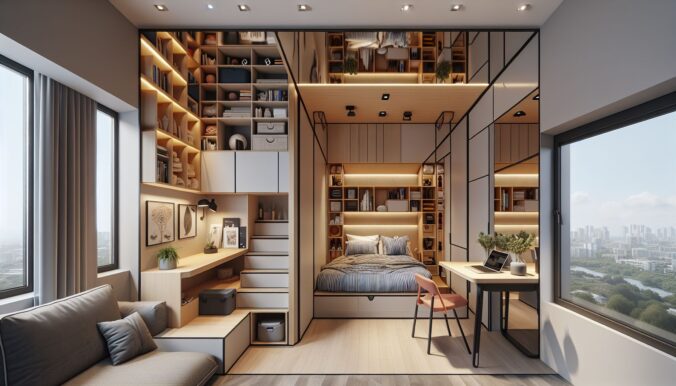Living in a small space doesn’t mean you have to compromise on style or functionality. With the right strategies and a bit of creativity, you can maximize every inch of your home and create a space that is both beautiful and practical. Here are some practical tips for efficient interior design that will help you make the most of your small space.
1. Start with a Plan
Before you start decorating, take the time to assess your space and create a plan. Consider how you will be using each area of your home and what furniture and accessories you will need. Think about the flow of the space and how you can make the most of natural light. By having a clear plan in place, you can avoid clutter and ensure that every item in your home serves a purpose.
2. Choose Multi-Functional Furniture
In a small space, every piece of furniture needs to work double duty. Look for multi-functional pieces, such as a sofa that can also serve as a guest bed, or a coffee table with hidden storage. Opt for furniture with clean lines and a light color palette to create the illusion of more space. Consider investing in modular furniture that can be easily rearranged to suit your needs.
3. Use Vertical Space
When floor space is limited, it’s important to make use of vertical space. Install shelves or cabinets high up on the walls to store books, plants, or decorative objects. Hang curtains close to the ceiling to draw the eye upward and make the room feel taller. Consider installing a pegboard or hooks on the walls to hang kitchen utensils or office supplies. By utilizing vertical space, you can free up valuable floor space and create a more open and airy feel.
4. Embrace Mirrors
Mirrors are a small space dweller’s best friend. Not only do they reflect light and make a room feel brighter, but they can also create the illusion of more space. Place a large mirror opposite a window to maximize natural light, or use a floor-length mirror to make a room appear larger. Consider using mirrored furniture or accessories to add a touch of glamour to your space.
5. Declutter Regularly
In a small space, clutter can quickly make your home feel crowded and chaotic. Make a habit of regularly decluttering and organizing your belongings. Invest in storage containers or baskets to hide away items that aren’t in use. Keep surfaces clear of clutter to create a sense of calm and openness. By keeping your space tidy and organized, you can make the most of every inch of your home.
6. Create Zones
Divide your small space into zones to make it feel more functional and organized. Use rugs, lighting, or furniture placement to define different areas for cooking, dining, working, and relaxing. Consider using a screen or bookshelf to create a visual separation between different zones. By clearly defining each area of your home, you can make the space feel larger and more cohesive.
7. Add Greenery
Plants are a great way to add life and color to a small space. Choose low-maintenance plants such as succulents or air plants that thrive in indoor environments. Place plants on shelves, countertops, or window sills to bring a touch of nature indoors. Consider hanging plants from the ceiling or using a vertical garden to maximize space. Not only will plants improve air quality, but they will also create a sense of calm and tranquility in your home.
8. Maximize Natural Light
Natural light can make a small space feel larger and more inviting. Keep window treatments light and sheer to allow as much light in as possible. Avoid blocking windows with furniture and opt for transparent or reflective surfaces that will bounce light around the room. Consider using mirrors to amplify natural light and brighten dark corners. By maximizing natural light, you can create a more open and airy feel in your small space.
9. Choose a Cohesive Color Palette
When decorating a small space, it’s important to choose a cohesive color palette to create a sense of unity and flow. Stick to a neutral or light color scheme to make the space feel larger and more open. Consider using different shades of the same color to add depth and interest. Use pops of color sparingly to create focal points and add personality to your space. By keeping your color palette cohesive, you can create a harmonious and visually appealing environment.
10. Personalize Your Space
Finally, don’t forget to add your personal touch to your small space. Display artwork, photographs, or mementos that are meaningful to you. Choose accessories and textiles that reflect your personality and style. Consider DIY projects or upcycling furniture to add a unique touch to your space. By personalizing your home, you can create a space that feels truly your own and brings you joy every time you walk through the door.
In conclusion, with the right strategies and a bit of creativity, you can make the most of your small space and create a home that is both efficient and beautiful. By starting with a plan, choosing multi-functional furniture, and using vertical space, you can maximize every inch of your home. Embracing mirrors, decluttering regularly, and creating zones will help you make your space feel larger and more organized. Adding greenery, maximizing natural light, and choosing a cohesive color palette will create a harmonious and inviting environment. And don’t forget to personalize your space to make it truly your own. With these practical tips for efficient interior design, you can transform your small space into a stylish and functional home that you love.
